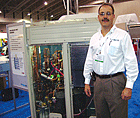
At the booth of Daikin AC (Americas) (www.daikinac.com), Russell Tavolacci, director of product marketing, explained the company's variable refrigerant volume (VRV) technology, which uses "an inverter-driven compressor to speed up or slow down refrigerant flow." It enables the outdoor unit to be modulated by the cooling or heating demands of the zone controlled. Available in heat pump and heat recovery formats, the system allows for individual control of up to 20 indoor units of varying capacities and types at a connection ratio of 50-130 percent compared to outdoor capacity.
The inverter heat pump system provides for either cooling or heating. The inverter heat recovery system provides simultaneous cooling and heating.
The VRV system delivers high efficiency during partial-load conditions by abbreviating the control steps into smaller units. Each indoor unit uses an electronic expansion valve to control the flow rate of refrigerant and maintain a nearly constant room temperature without the temperature fluctuations of a conventional on-off system.
In addition to these commercial systems, Daikin displayed its single-phase VRV-S system for light commercial and high-end residential applications, and also its mini-splits with inverter technology, rated at up to 17 SEER, for residential and light commercial use.
Tavolacci noted that Daikin is "developing more training centers to bring training to the contractor."
Honeywell Building Solutions (www.honeywell.com/building solutions) showed elements of its Enterprise Buildings Integratorâ„¢ (EBI), which is designed to integrate existing building systems such as HVAC and lighting systems, energy management, security, life safety, and more. George Breig, sales systems consultant for Honeywell, said it is "a scalable solution" that enables the user to "do the right thing at the right time."
The EBI suite of applications includes Building Managerâ„¢, which provides control of HVAC, lighting, and electrical equipment; Energy Manager, which integrates energy management across the enterprise; Security Manager, which integrates building access and security systems; LifeSafety Manager, which integrates building fire safety; Digital Video Manager, which integrates video with the enterprise system; and Asset Locator, which provides for monitoring of physical assets and people.
Schneider Electric (www.us.schneider-electric.com) introduced the latest in its line of Telemecanique® Altivar® variable-speed ac drives, the Altivar 61 drive. According to the company, with its wide range of functions for centrifugal pumps and fans, the drive provides an easy-to-use product with a high level of customization and energy efficiency. The Altivar 61 drive reduces energy costs by adjusting motor speeds to match the required flow. The drive offers a wide hp range - from 1 to 900 hp - and multiple I/O and communication options.
John Dierkes, national sales manager, energy efficiency, for Schneider's Square D brand, also noted that the company "has just launched a new energy efficiency Website under the Square D name." Called Square D Lean Tools, it is a collection of Web calculators that allow users to estimate potential energy savings that can be gained from implementing various energy efficiency solutions.
"Easy to install, relocate, and manage, the SensiNet Energy Management Solution continuously collects information on energy consumption and correlates it with simultaneous measurement of the health of the underlying electromechanical system," said Gary Ambrosino, CEO of Sensicast. "The collected data is passed over the Sensicast wireless mesh network and made available over the Internet for instant assessment and analysis. This gives plant operators a new way to head off problems that lead to the inefficiencies that can result in wasting electricity."
Trane (www.trane.com) was highlighting and demonstrating the high-efficiency chiller plant installed at the Washington Convention Center, site of the WEEC. The convention center covers six city blocks and the Washington Convention Center Authority contracted with Trigen-Pepco Energy Services to build and operate the central chiller plant. Trigen-Pepco engineers worked with Boland Trane, Rockville, Md., to design the plant.
M. Todd Brown, manager, international chiller products for Trane, said that six Trane high-efficiency centrifugal chillers totaling 10,500 tons capacity were installed in a series/parallel pumping configuration. Since today's chillers are much more efficient, Brown said the idea was to "move work from the pumps and cooling tower to the chiller." With low chilled water temperature and low flow rate, pumps, piping, air handlers, and ductwork can be smaller than a traditional system, saving on materials costs.
Commissioned in 2003, Brown said the chiller plant "has been very successful." Plus, the highly efficient system "is good for the environment, since it reduces CO2 emissions."
Trane also showcased its new CDQâ„¢ (Cool, Dry, Quiet) unit, which is used to enhance the dehumidification performance of a traditional cooling coil. The CDQ desiccant wheel is configured in series with the cooling coil to significantly improve the coil's ability to remove moisture. "It recirculates moisture until it gets condensed out," noted Bruce Bradway, senior applications engineer.
Bradway said the CDQ is used to assist an air handler or a rooftop unit in dehumidifying. According to the company, adding the CDQ to a Trane air handler can double or even triple the amount of water removed.
WaterFurnace (www.waterfurnace.com) displayed its new EW and EKW Series reversible chiller. The water-to-water heat pump is available in 30- and 50-ton models. The units can be combined to increase capacity.
Carolyn Beck, business development manager, WFI Global, a division of WaterFurnace International Inc., noted that the unit "runs on R-410A refrigerant to provide an energy efficient and environmentally friendly product." With its compact size, "it can fit through a doorway." The compact enclosure also "makes for a clean mechanical room," said Beck. Units are controlled using a Johnson Controls FX10 microprocessor which sequences all components and functions to maximize performance, and allows connection to a building automation system utilizing BACnet, LonWorks, or N2 Open protocols.
Publication date: 10/23/2006




